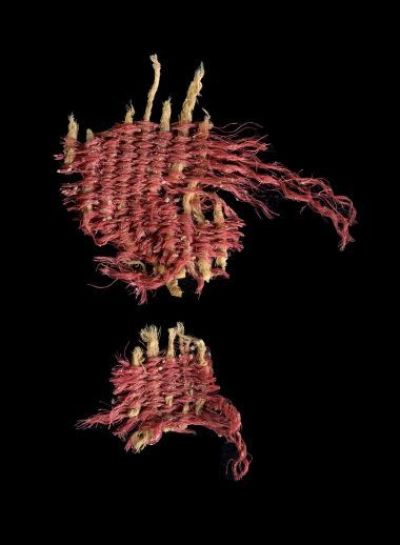Archaeologists find evidence of 'scarlet worm' red dye mentioned in the Bible

Fresh color has been added to the black-and-white text of the Scriptures thanks to the combined efforts of researchers working together on an extensive project to identify dyes in archaeological textiles.
A piece of rare textile measuring less than 2 centimeters in size has offered the earliest evidence of the use of scale insects to create red dyes ever found.
The fragment was discovered in 2016 in the "Cave of Skulls" in the Judean Desert in the course of excavations carried out by the Israel Antiquities Authority (IAA) and the Hebrew University as part of efforts to thwart antiquities thieves in the race to recover precious artefacts.
The team of researchers was led by Naama Sukenik from the IAA, and professors Zohar Amar and David Iluz from Bar-Ilan University, and was supported by the Israel Science Foundation.
They found that the 3,800-year-old textile contained dye from oak scale insects, or kermes, which they identified with the biblical reference of "Tola'at Hashani" (scarlet worm). In an article submitted to the Journal of Archaeological Science: Reports, the researchers described the technology used to analyze the dye, and how carbon-14 was used to date the fragment to around 1767-1954 BC in the Middle Bronze Age.
"Identifying the dye in the ancient textile was achieved using High-Performance Liquid Chromatography (HPLC), a device commonly employed in biology and chemistry laboratories to separate and identify substances in minute quantities, and it also serves archaeology," Sukenik wrote.
"This advanced analytical method enabled us to pinpoint the dye's origin down to the exact species of scale insect."
Its distinctive scarlet-red color was prized as one of the ancient world's most precious and expensive dyes, and there are numerous mentions of kermes, an oak tree that was the source of the beetles, in ancient trade documents, including cuneiform tablets from Mesopotamia, dating back to 1425 BC.
"In the Bible, the dye extracted from oak scale insects is referred to as 'scarlet worm,'" said professor Zohar Amar of Bar-Ilan University.
"Worm" was used as a general term for various insects and their developmental stages in ancient times, and a reference to the color "scarlet worm" appears 25 times in the Bible. Often mentioned alongside blue (Tekhelet) and purple (Argaman), the most precious and prestigious colors of the ancient world, it appears in association with luxurious clothing, Tabernacle textiles, and in other cultic contexts.
Despite the extensive written historical evidence for the widespread use of dyeing with scale insects in the ancient world, very few physical specimens of kermes-dyed fabric predating the Roman period have survived, and this colorful relic possesses a historical heft that belies its modest dimensions. Not only does it provide a direct link to the pages of the Bible, serving to remind us that the historically remote terms and phrases we find in Scripture represent things that were a very real part of their day-to-day world, but it also offers insight into Israel's interactions with the wider world.
"Although it was discovered that Israel has a native species of scale insect living on Palestinian oak (Quercus calliprinos), capable of producing a red-orange color, the analytical results indicate that in the case at hand, the species of scale insects is Kermes vermilio which lives on the kermes oak tree (Quercus coccifera)," said professor Iluz.
"This tree species is common in the Central and Eastern Mediterranean region, including Spain, France and other areas, but is not found in the Land of Israel."
While a little dye and some insects might not seem that important a discovery at first glance, their cultural significance means that they have been able to provide a wealth of information about a whole cross-section of society.
"The important find bridges the gap between written sources and the archaeological discoveries, providing evidence that the ancient textile dyeing industry was — already at this stage, sufficiently established for dyeing using animals," added Sukenik.
"The rare textile is a testament to broad international commercial networks functioning already at this time and indicates the presence of an elite society."
Originally published by Christian Today




























